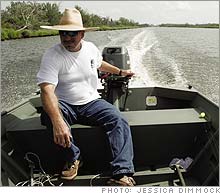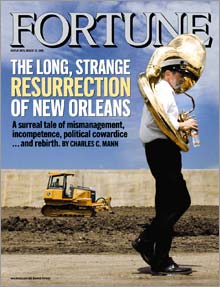|
How the energy business is drowning Louisiana America's oil and gas infrastructure needs Louisiana's coastal wetlands. But it is helping to destroy them, Charles Mann reports for Fortune.
NEW YORK (Fortune) -- The swampland of coastal Louisiana, often thought of as a folkloric backwater, is in fact the nation's most important petrochemical complex: an archipelago of some 4,000 oil and gas platforms. Glowing like rejected sets from Waterworld along the shore, 17 giant petroleum refineries and more than 180 petrochemical plants gush out jet fuel, lubricants, and scores of other products. (The state also hosts two of the four Strategic Petroleum Reserve storage facilities and about 15,000 smaller land-based oil wells.) Taken together, Louisiana and the area off its coastline produce or transport 30 percent of the nation's domestic crude oil and 34 percent of its natural gas; it also refines 16 percent of our petroleum. And the complex is growing. As energy demand rises, industry has proposed erecting 13 more liquid-natural-gas terminals in the United States. Four will be on the Louisiana coastline (another six will be just across the border in Texas). And Congress, responding to high gas prices, is about to open still more of the continental shelf to oil and gas exploration. This entire infrastructure depends on the continued existence of Louisiana's coastal wetlands (and New Orleans, with its port, airport, hospitals, and so on). Unfortunately, it is helping to destroy them. Vanishing land For geological reasons, southern Louisiana has been slowly sinking for millennia. In the past, the Mississippi River offset this natural decline by periodically flooding the delta, depositing huge amounts of silt. Kept in an unsteady equilibrium, the wetlands acted as a buffer, protecting the land from the full fury of hurricanes. Today, flood-protection levees channel the river and its silt deep into the Gulf of Mexico, so the land is no longer being built up. Worse, humankind is making the problem worse - actually increasing the region's vulnerability to storms. A big culprit is what President Bush might describe as Americans' "addiction to petroleum." The petrochemical industry pumps out its harvest of petroleum and chemicals from Louisiana through approximately 35,000 miles of pipeline (nobody seems to know the exact figure). Much of this fabulous network is offshore, but some 14,800 miles of it slice through the coastal wetlands. So do 3,000 miles of navigation channels. Many of these cuts into the swamp bring salt water inland, killing the grass and trees that prevent the wetlands from eroding. Boat wakes lap at the edges of the channels, nibbling away at their edges. In only a few years a healthy bog can float away into the Gulf of Mexico. "The land doesn't submerge like Atlantis," says Denise Reed, a geomorphologist at the University of New Orleans. "It changes into water." As much as 24 square miles of land vanish every year. As a result, the wetlands form an ever-smaller protective buffer, both for the city of New Orleans and the immensely valuable complex of refineries, ports, wells, and platforms around it. 'The real unknowns are money and political will.' The Mississippi twists and turns for 95 miles from New Orleans to its mouth. This stretch of water is where much of the river's remaining silt accumulates, which makes the course treacherous and means it must be dredged frequently. To create a straight, reliable path between New Orleans and the Gulf of Mexico for the region's huge oil, chemical fisheries and agricultural shipments, the Army Corps of Engineers dug a 76-mile shortcut: the Mississippi River Gulf Outlet - MRGO, or "Mister Go," as it was inevitably dubbed. In 1963 the passenger ship S.S. Del Sud made the first transit of the new channel. Considerable dispute exists as to whether MRGO has since lived up to its economic promise. No one disputes that it has been an ecological headache. MRGO cuts through St. Bernard Parish, on the eastern edge of the city, and connects to the Gulf Intracoastal Waterway, a federally built inland water highway that, among other things, allows barges to cut straight from another part of the Gulf of Mexico to New Orleans, also bypassing the treacherous Mississippi. The combined channel then Ts into the canal between the river and Lake Pontchartrain. This maze of connections allowed saltwater to move from the Gulf all the way to Lake Pontchartrain, killing a wide swath of marsh vegetation as it went. Erosion from vessels passing through MRGO stretched its width from 650 feet to, in places, more than 2,000 feet. So much erosion occurs that the channel regularly silts up, just like the Mississippi. Four years after the inaugural passage of the S.S. Del Sud, it ran aground in MRGO. The ship was stuck for two days. In ecological terms, the solution to MRGO is obvious: Shut it down. But that would be complicated and expensive. So would bringing back the rest of coastal Louisiana - indeed, the task would cost at least $14 billion, according to Coast 2050, the most comprehensive study of the topic. Adding to the challenge, restoration teams would be working at a time when, according to many scientists, global warming is pushing up sea levels and making hurricanes more violent. Meanwhile the Mississippi's supply of land-renewing sediment has dropped by 50 percent in the last century, because upstream dams now block much of the silt. Nonetheless, most scientists believe that the wetland loss can be stopped and even partly reversed. "We've run about 150 pilot projects to restore small areas," Reed says. "We understand a lot about how these systems work. The real unknowns are money and political will." Until recently, both have been in short supply, not least because, as Louisiana Senator Mary L. Landrieu observes, "nobody's ever tried to save an entire delta before - it's never been done, and that's the kind of thing that very understandably makes people here [in Capitol Hill] nervous." Cross your fingers After almost a decade of negotiation between the state and the Army Corps of Engineers, a draft restoration plan emerged at the end of 2003 - only to be bounced by the White House Office of Management and Budget. According to Sidney Coffee, the Louisiana governor's executive assistant for coastal activities, OMB demanded that the Corps "immediately cease all work on the plan." Scrapping the consensus of three state bodies, five federal agencies, twenty parishes, and countless researchers and engineers, OMB set a budgetary ceiling of $2 billion. "I never found out how they arrived at that figure," Coffee says. "It was a huge blow for us, because it was obviously not enough." Ultimately, though, Louisiana asked for $1.7 billion in the Water Resources Development Act. WRDA is a $10-billion omnibus bill authorizing expenditures for water-related projects around the nation. It is beloved by politicians and hated by policy wonks for the same reason: It is swollen with pork and corporate welfare. In theory, Congress is supposed to revise and reauthorize the law every two years. In fact, it has not passed WRDA since 2000, because the bill became hostage to a political dispute over reforming the Army Corps of Engineers. The latest version of WRDA was introduced in April 2005. Because both the House and Senate want to have some accomplishments to show the voters before the mid-term elections, prospects for action look brighter than they have for years. Congress, Landrieu says, should "move this law before November." On one level, the tepid response to what may be the nation's biggest environmental problem is inexplicable. Originally the petroleum industry located its refineries and plants in Louisiana to take advantage of the nearby oil and gas platforms, but it expanded their scope because the state, for better and worse, is one of the few that welcomes petrochemicals. "If the coastal environment became unsustainable, I don't know what other state would accept these facilities," says David Pursell, an analyst at Pickering Energy Partners, an investment-research group in Houston. "In Massachusetts, people are fighting wind farms." Since 1978 the United States has not erected a single new oil refinery; all growth in capacity has come from adding on to existing plants, including those in Louisiana. The political impossibility of recreating the state's huge petrochemical complex elsewhere is rarely noted in the glib dicta, heard occasionally from economists, that the coast should not be rebuilt. Americans in the other 49 states, in Pursell's view, should be "crossing their fingers" that Louisiana "will continue to be able to host these places." And that will depend on whether the Louisiana coastline exists tomorrow in something like its present configuration. _________________________________
|
|


